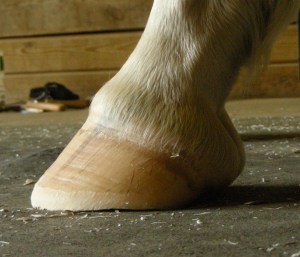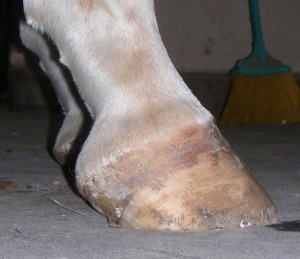A 5 yo Hanoverian/TB X gelding
Shoes were removed in December. The images represent his progress over the course of the next 5 months.
Left Front Foot


Fig. 1 Fig. 2


Fig. 3 Fig. 4
The long toe is progressively coming back into better proportion.
A better hoof/ pastern alignment is visible in the subsequent views.
Right Hind Foot

Fig. 1 Fig. 2Too high heel resulting in steep hoof/pastern alignment improving.
Fig. 1 Fig. 2 Flare is being reduced and medial and lateral walls and inside high condition is improving.
The horse has started to compete at unrecognized Combined Tests, and is doing well.




This is a good article. I have 10, 8 that are barefoot. We are always questioning the club foot issue with one of the shod horses. Please keep the posts coming. The information on your sight is so needed.
What an info, this is great for a horse lover like me but just a beginner one so I do really love this kind of post. Keep posting buddy.
I have a really good example of a longtoe/low heel with hyperextension of the coffin bone that I fixed in 5 months. You can see the photos on my web site under case studies.
Hi, all of mine are barefoot behind now, but my farrier leaves my mare with a very noticable flare to the inside hoof wall. Any idea why he does this? I will ask next time but am just really curious now!
impossible to say without pictures but flstrs are usually the result of ML imbalance. However most often it is am inside high wall causing a flare on the outside. Perhaps your horse has an ourside high wall which is uaising a flare and your farrier is not balancing the foot properly.
I find that most flares are due to long bars which bulge outward causing the heel to migrate forward under the foot and the lateral and medial walls contiguous to the lateral cartilages to flare out. This goes along with the toes migrating forward, Get the bars to behave! Back the toes up, and trim those bars so that they grow straight, give the heel a “purchase” to pull the whole thing back, All this will pull the flare in. Of course you can rasp the flares but all this does is thin the lateral walls. And
this takes time because the existing laminar walls are stretched so new ones have to grow back in tighter.
Interesting info on angles. Alot of farrier (both barefoot and conventional I might add), don’t seem to understand the angles correctly. To many problem caused in the long run.
So interesting..my OTTB (barefoot) has the most vertical club on his front Right….despite our best efforts, it’s still clubbie. Is it best to really go SUPER low on heel or will that throw things out of whack as nature intended?? Assuming nature is saying that leg is shorter so needs a taller hoof?
HI Kristen,
Having one short leg is extremely rare. It sounds like your horse has heel pain and is not weighting his heel on the ‘clubby’ foot therefore the heel keeps growing higher. Simply lowering the heel is usually not the answer. You have to identify the source of the heel pain, whether it is contraction, imbedded bar, or something else. Once you remove the source of the heel pain, he will be more willing to weight in and then it will start growing more slowly and maintain a similar height to the other foot.
Christina-
How can I test for heel pain? I don’t see any imbedded bars as they grow and we keep them trimmed down… I don’t think he’s contracted either.
Would xrays give me a clue?
Could it be something else? I seem to treat thrush in that Frog more…but currently I dont believe he has thrush there….I know I’m missing a sign or something, but how do I figure it out?
Thanks!!
I really don’t think a horse with some age on him (say from 6 on) can be significantly corrected on a true club foot. But many, many horses have high heels and bars and removing the cause of the pain may, along with therapy, help to improve the situation as Christina says. However, after several many years of experience and trying to correct old hopeless cases, I have learned that there are so many other factors that it’s often idealistic to expect only corrective trims to effect long-term cures.